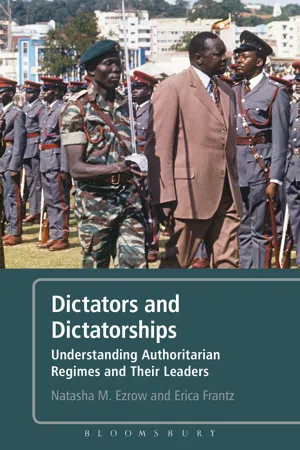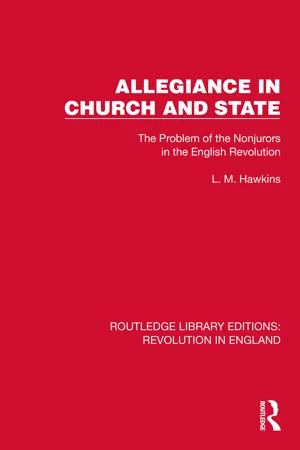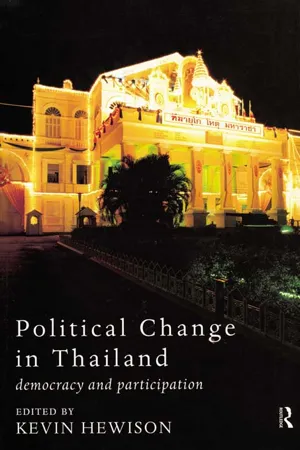History
Monarchy
Monarchy is a form of government where a single individual, usually a king or queen, holds supreme authority and power. In a monarchy, leadership is typically hereditary, passing from one generation to the next within a ruling family. Monarchies have been a prominent form of government throughout history, with variations in power and influence depending on the specific monarchy and time period.
Written by Perlego with AI-assistance
Related key terms
4 Key excerpts on "Monarchy"
- eBook - ePub
Unsteady Crowns
The Survival of Monarchies in the Modern World
- A.W. Purdue(Author)
- 2011(Publication Date)
- The History Press(Publisher)
What is not always recognised is that coronation and consecration divest the monarch of his or her individuality and past identity. The monarch becomes separate from the run of humanity. Most early artistic portrayals of monarchs are iconic and impersonal; they concentrate upon the crown rather than the man. The separation of the person from the office is shown most clearly in the naming of kings. Eastern traditions demonstrate a greater continuity here, with, as in China, the emperor’s former name never mentioned, or, as in Japan, the emperor’s reign being given a special auspicious name, which becomes the monarch’s name after his death. Even in Europe, the monarch chooses the name by which he will be known as king, with, in Britain, Alberts and Davids becoming Georges or Edwards.Royal authority has been the norm for the greater part of human history, and the idea of the monarch as head of a family, the head of an organic community of which he or she is the expression, remains as true of Monarchy today as at its beginnings. The early origins of Monarchy lie in literal kinship with the rule of the chieftain, who was the patriarch of the family, the leader in war and the priest. Such relations between ruler and ruled can still be found today in Africa and parts of the Middle East. The chieftain’s office was not necessarily based on primogeniture but was hereditary in that rulers were usually chosen from a leading family. The early monarch was the lawmaker or law interpreter, the general or protector, and the intermediary between the spirits and the living, the past and the present. Early peoples felt perpetually threatened, and, it has been argued, the beginnings of kingship were probably located in their quest for protection ‘against myriad hostile forces – natural, supernatural and human’.2 - eBook - ePub
Dictators and Dictatorships
Understanding Authoritarian Regimes and Their Leaders
- Natasha M. Ezrow, Erica Frantz(Authors)
- 2011(Publication Date)
- Continuum(Publisher)
The leader of the regime is typically a king or prince, and regime elites are usually members of the royal family. The legitimacy of the regime and of key regime actors is tied closely to bloodlines and family lineage. Leadership succession in monarchies is institutionalized. Though it is not necessary for primogeniture to be used, the transfer of power from one leader to the next must be in accordance with an accepted practice. 3 In monarchies, a ruling family dominates the political sphere, with key posts held by members of the ruling family and their allies. Some monarchies have legislatures and elections, though they are not vehicles for leadership selection. Some also allow political parties to form and operate. As in single-party dictatorships, however, these institutions are typically tools for the regime’s survival rather than means for contesting politics or directing policies. Definition of Monarchy • Royal family in power, with king or prince at the helm • Clearly defined rules for succession • Legitimacy of the leadership based on bloodlines • Ruling family in charge of the military and policy • Legislatures, political parties, and elections occasionally legal, but subordinate to the family Theoretical Analyses of Monarchies Compared to the literature on other forms of dictatorships, few studies have been dedicated to monarchic rule. Though the scholarship devoted to monarchies is expanding quickly, it is still relatively underdeveloped. In this section, we present the central threads of this literature, discussing the different types of monarchies, how they are structured, and the factors that contribute to their durability. Types of Monarchies Dynastic and Non-Dynastic Monarchies Monarchies are split into two groups by Michael Herb: 4 dynastic and non-dynastic. In dynastic monarchies, the royal family forms a ruling institution; in non-dynastic monarchies, the monarch rules alone - eBook - ePub
Allegiance in Church and State
The Problem of the Nonjurors in the English Revolution
- L.M. Hawkins(Author)
- 2023(Publication Date)
- Routledge(Publisher)
CHAPTER III THE ORIGIN AND AIMS OF MONARCHICAL GOVERNMENT1. Monarchy.
Amid all the political controversy engendered by the Revolution of 1688, there was never any serious doubt cast by either section of the Anglican Church on the pre-eminence of Monarchy as an instrument of government. Monarchy as the core of the English Constitution was taken for granted. Interminable arguments concerning the method of succession, the nature of authority and its original source, raged between the two parties, but there was fundamental agreement about the basic rightness of Kingship. Monarchy was the express institution of God, and all other forms of government were contrary to his known will. In a phrase of Hickes “Kings are God’s Vicegerents upon earth, and the supreme, especially the Royal, power is the ordinance of God.”1 Commonwealths and democratic governments had their births among pagan peoples, and were not only dangerous but sinful, and the Anglican politician was not slow to draw illustrations of their wickedness from the experiences through which his Church and country had passed in the middle years of the century. Aristocracies led to faction and strife no less certainly than did popular government. It was acknowledged that the bad government of Princes or the licentiousness of peoples had on occasion merited punishment by the overthrow of established order in favour of one of these debased forms, but in the experience of England such incidents were in the nature of a political disease and were not regarded as valid arguments against the institution of Monarchy itself, an institution which was so much an integral part of Anglican political theory that it was accepted without discussion.1 Sermon preached at Bow Church, before the Lord Mayor of London, 1682.2. The Succession.
- eBook - ePub
Political Change in Thailand
Democracy and Participation
- Kevin Hewison(Author)
- 2002(Publication Date)
- Routledge(Publisher)
Bangkok Post (BP) 9 December 1987), these will not be examined here. Instead, attention will be on the Monarchy as an institution and the way this institution has been shaped and changed as constitutional political forms have developed. This chapter begins with a brief explanation of common perspectives on the Monarchy. This is followed by a discussion of the political philosophy of the present King and some of his closest advisers. The emphasis is on their definition of the constitutional Monarchy and its role in democratisation.THE ‘STANDARD TOTAL VIEW’ OF THE Monarchy
This section briefly summarises the ‘standard total view’ of the Monarchy.4 The present King is seen to be a truly great man. One popular account states: ‘His Majesty…is a man of many versatile interests and abilities which have brought him international acclaim and recognition together with the pride and devotion of his own people’ (Rosenthal 1988:9). Some go further, with Nation Publishing (1988:11) stating that the King has ‘expertise in virtually all fields of human endeavour’. The adoration for and popularity of King Bhumibol has become an important element of the Monarchy's public image. This image is ‘protected by jealous courtiers against comment that most monarchies might shrug off’ (Kulick and Wilson 1992:60–1). Indeed, the penalties for lèse majesté have been increased in recent years, and few who are charged escape penalty (Streckfuss 1993). Nevertheless, the popularity of this King is seen to be due to his own hard work and his occupation of the throne at the end of a long line of other multi-talented monarchs (see Van Praagh 1989:17–21).Indeed, the version of history promoting this view draws a direct link between the present-day Monarchy and thirteenth-century Sukhothai. For example, Tongnoi (1990:156) states that Thailand has ‘continuously’ had a king on the throne since the earliest historical times (Office of His Majesty's Principal Private Secretary [OPPS] 1987:7–8). To this is added the assertion that Thailand's avoidance of direct colonialism was due to the talents of ‘good’ kings (ibid.: 7). Good kings are divine, even magical, and this is supported by the monarch's religious role, and by the King's sponsorship of Buddhism (see Kukrit 1988:4–5; OPPS, 1987:51). Well-known royalist and adviser to the King, Thanin Kraivixien (cited in Heiecke 1977:31) notes that Thai kings are a mixture of father figure and God-king.5 Above all, the King must be virtuous, upholding the ten virtues of the good Buddhist monarch (Phaya 6 Srivisarn 1954).7
Index pages curate the most relevant extracts from our library of academic textbooks. They’ve been created using an in-house natural language model (NLM), each adding context and meaning to key research topics.



